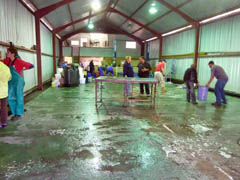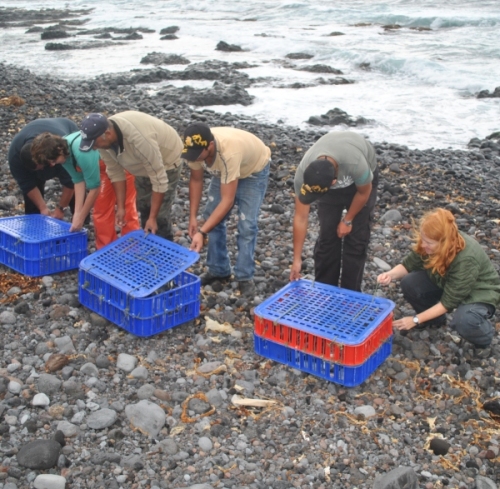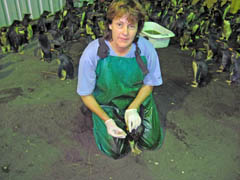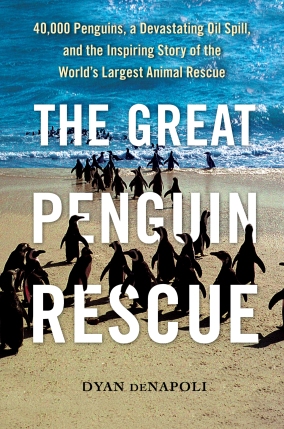There has not been much news coming out of Tristan over the last few days. I imagine this is due to rescuers working non-stop on the creation of a temporary rehabilitation facility on the main island (Tristan da Cunha). Once the ship from Cape Town arrived last Tuesday, the rescue team from South Africa immediately set about preparing this center and triaging thousands of oiled penguins. This team brings with them a great deal of experience managing large-scale penguin and seabird rescue operations (including the Apollo Sea, Cordigliera, and Treasure oil spill rescues). So, for today, I am taking the following news directly from the official Tristan da Cunha website. This is their most recent report, which was posted last Wednesday, April 6th.
Wednesday 6th April Report from RSPB Project Officer Katrine Herian – Tug Singapore unloads
On the afternoon of Tuesday 5 th April, after seven days at sea on board the support tug Svitzer Singapore, the SANCCOB team were able to get ashore at Tristan while offloading began of the specialist equipment and materials needed for washing the penguins. Vital vitamins and medicines also came ashore and these were already being put to use in the rehab centre’s intensive care unit later than evening. Venessa Strauss, CEO at SANCCOB (The Southern African Foundation for the Conservation of Coastal Birds) reported the team were relieved to get ashore, as bad weather had kept them on board the tug Singapore one extra day which had been very frustrating. Offloading SANCCOB’s equipment from the “Svitzer Singapore” continued throughout Wednesday, and weather permitting should be completed on Thursday 7 th April.

The Svitzer Singapore (the tug from Cape Town) unloading at Tristan on April 5th. Photo by Katrine Herian
SANCCOB Team impressed with Tristan rehabilitation effort
This morning the five members of the SANCCOB team including Veterinarian Tertius Gous, met many of the islanders involved in the rehab operation as they started their daily shift tubing and feeding the penguins. The SANCCOB team were impressed with the set up at the rehab centre and praised the islanders’ efforts under difficult conditions and with very limited resources. It is now two weeks since the first oiled penguins arrived at the rehab centre, and three weeks since the OLIVA grounded on Nightingale Island.

Environmental Advisor and former SANCCOB Centre Manager, Estelle van der Merwe, watches as volunteers feed the penguins. Photo by Tina Glass
Cleaning operation planned
Today work began on installing specialist equipment at the wash-bay facility which will be housed in two government containers close to the rehab shed. Here hot water geysers will be installed for the penguin-washing operation (to remove the heavy bunker oil), as well as infrared lights in a drying room. Outside, large tanks will collect and separate the waste-oil/solids and grey water from the washing process. SANCCOB logistics manager Mariëtte Hopley reported the washing facility would be up and running on Friday, when training would begin for islanders in the washing of penguins.
The rehab shed was cleaned out and disinfected before turning it into a dedicated unit for sick and weaker penguins. Working closely with the island rehab manager Dereck Rogers, the SANCCOB team separated penguins by habitus, with the very weakest penguins being moved into the rehab shed.
Pilchards imported to supplement local fish food for penguins
By midday the first boxes of frozen pilchards had come ashore and were being defrosted and fed to the stronger penguins which are being prepared for “washing” over the weekend. Each penguin was fed one pilchard for the first day, as they need to get used to the change in diet from the local yellowtail and five fingers fish fed to them thus far.
Outer islands oil pollution assessment
Dr. Mark Whittington (of ITOPF) , and Mr. Jean-Luc Dardidon (of Le Floch), visited Middle & Nightingale Islands to assess the residual oil remaining in the bays and on the rocks after the OLIVA grounded on the 16 th March. A plan shall shortly be formalised to deal with the remaining oil, and to prevent further impact on the penguin and bird colonies.
BRIEF UPDATE:
A helicopter is supposedly on standby on another ship (the Ivan Papanin) that is waiting to head to Tristan from Cape Town. The chopper will be of tremendous help in moving penguins off of the islands, monitoring the number of birds still on the islands, and transporting clean penguins away from the oil-contaminated waters in the area. I will have another update about this in my next post (which will be later today or tomorrow).
To read more about this penguin rescue (and to see more photos), visit the official Tristan da Cunha website here. This page commences with the first rescue of oiled penguins on March 19, 2011.
PLEASE HELP BY DONATING TO THIS PENGUIN RESCUE EFFORT TODAY!
While the ship’s insurers are supposed to pay for rescue and clean-up efforts, this takes a long time – and, from what I understand, there has been little or no response from the owners and insurers of the MS Oliva. Without help from the outside world, these endangered penguins (and other seabirds) are at great risk. The islanders and the small team of rescue professionals currently on Tristan da Cunha are doing everything they can to save these oiled birds, but they need funding to carry out this critical rescue mission. Please let them know they are not alone in this – you can help them by donating generously to one of the following groups today. And please spread the word! Thank you!
The Ocean Doctor (Dr. David Guggenheim): http://oceandoctor.org/ (Click on the green ‘donate now’ button in the right-hand column.) Or go to this link: Nightingale Island Disaster Penguin and Seabird Rescue Fund
Royal Society for the Protection of Birds: Nightingale Island Emergency Appeal
Foundation for Antarctic Research: Catastrophic Oil Spill – Tristan
Dyan deNapoli (The Penguin Lady) – author of The Great Penguin Rescue






